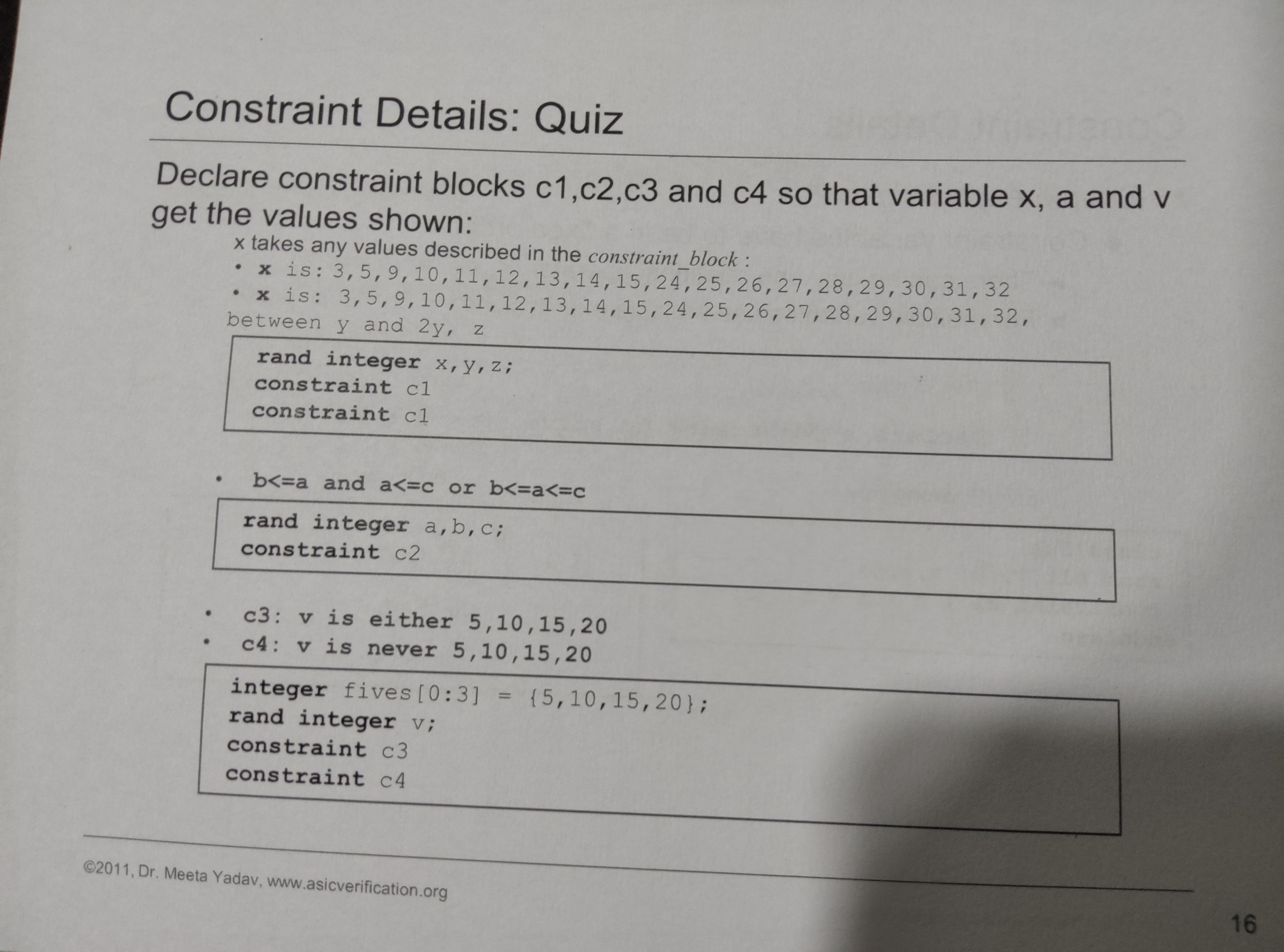Declare constraint blocks c1, c2, c3, and c4 so that variable x, a and v get the values shown: x takes any values described; b=a and a<=c or b<=a<=c; v is either 5,10,15,20; v is n... Declare constraint blocks c1, c2, c3, and c4 so that variable x, a and v get the values shown: x takes any values described; b=a and a<=c or b<=a<=c; v is either 5,10,15,20; v is never 5,10,15,20.

Understand the Problem
The question is asking to declare constraint blocks c1, c2, c3, and c4 for variables x, a, and v based on specified conditions and ranges.
Answer
```plaintext constraint c1 { x in {3, 5, 9, 10, 11, 12, 13, 14, 15, 24, 25, 26, 27, 28, 29, 30, 31, 32}; } constraint c2 { (b == a && a <= c) || (b <= a && a <= c); } constraint c3 { v in {5, 10, 15, 20}; } constraint c4 { !(v in {5, 10, 15, 20}); } ```
Answer for screen readers
constraint c1 {
x in {3, 5, 9, 10, 11, 12, 13, 14, 15, 24, 25, 26, 27, 28, 29, 30, 31, 32};
}
constraint c2 {
(b == a && a <= c) || (b <= a && a <= c);
}
constraint c3 {
v in {5, 10, 15, 20};
}
constraint c4 {
!(v in {5, 10, 15, 20});
}
Steps to Solve
-
Declare Random Variables for x, y, z
We start by defining random integer variables $x$, $y$, and $z$. This will allow us to create constraints for these variables.
rand integer x, y, z; -
Define Constraint c1 for x
Create constraint block $c1$ to specify the possible values for $x$. The values are: 3, 5, 9, 10, 11, 12, 13, 14, 15, 24, 25, 26, 27, 28, 29, 30, 31, 32.
constraint c1 { x in {3, 5, 9, 10, 11, 12, 13, 14, 15, 24, 25, 26, 27, 28, 29, 30, 31, 32}; } -
Declare Random Variables for a, b, c
Now, we will declare random integer variables for $a$, $b$, and $c$.
rand integer a, b, c; -
Define Constraint c2 for a, b, c
Create constraint block $c2$ to specify the conditions where $b=a$ and $a \leq c$ or $b \leq a \leq c$.
constraint c2 { (b == a && a <= c) || (b <= a && a <= c); } -
Define Constraint c3 for v
Declare integer array for possible values of $v$: 5, 10, 15, 20 and create constraint block $c3$.
integer fives[0:3] = {5, 10, 15, 20}; rand integer v; constraint c3 { v in {5, 10, 15, 20}; } -
Define Constraint c4 for v
Lastly, create constraint block $c4$ to specify that $v$ should never be 5, 10, 15, or 20.
constraint c4 { !(v in {5, 10, 15, 20}); }
constraint c1 {
x in {3, 5, 9, 10, 11, 12, 13, 14, 15, 24, 25, 26, 27, 28, 29, 30, 31, 32};
}
constraint c2 {
(b == a && a <= c) || (b <= a && a <= c);
}
constraint c3 {
v in {5, 10, 15, 20};
}
constraint c4 {
!(v in {5, 10, 15, 20});
}
More Information
The constraints created here specify the allowable values for the variables $x$, $a$, and $v$, ensuring that they all comply with the conditions described. This is useful in scenarios such as validating input values or optimizing certain operations based on given rules.
Tips
- Forgetting variable types: Always declare the type of variables (e.g., integer) before using them in constraints. Ensure the random integers are clearly defined.
- Improper syntax in constraints: Make sure to follow the correct syntax for defining logical expressions and set memberships.
AI-generated content may contain errors. Please verify critical information